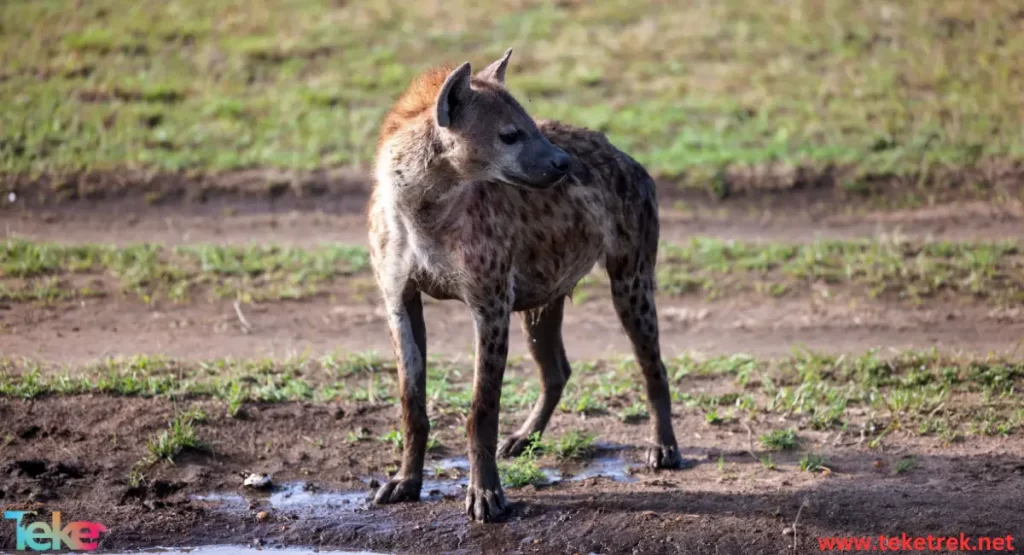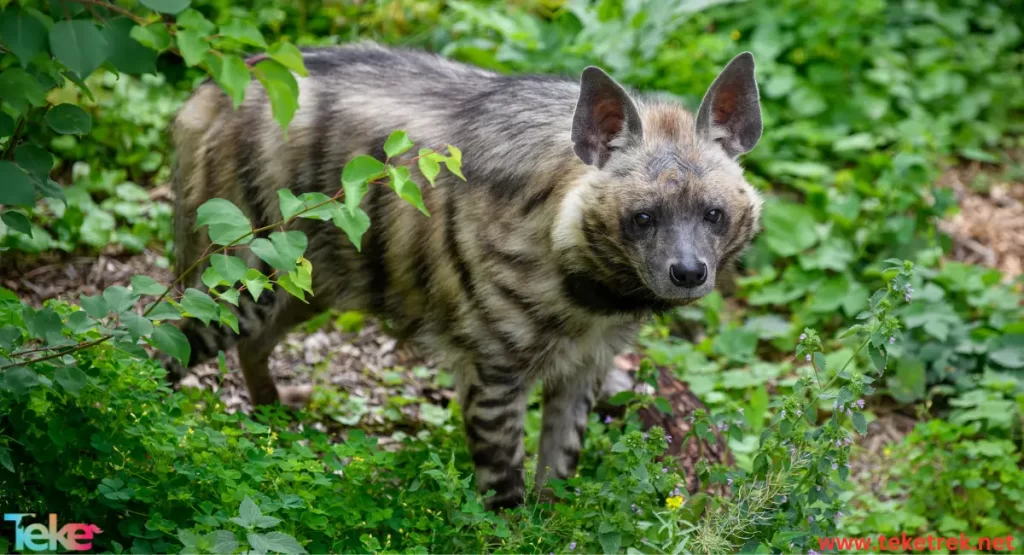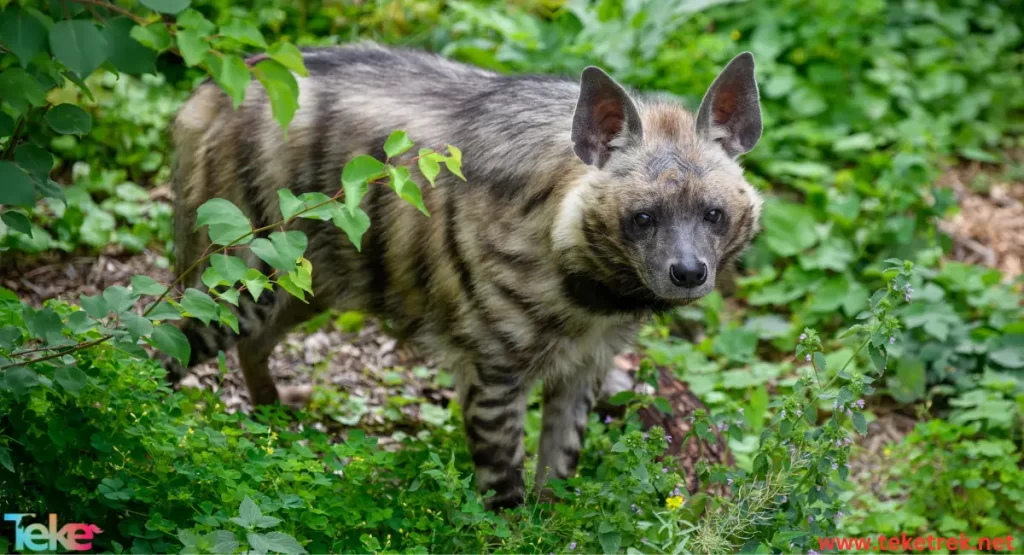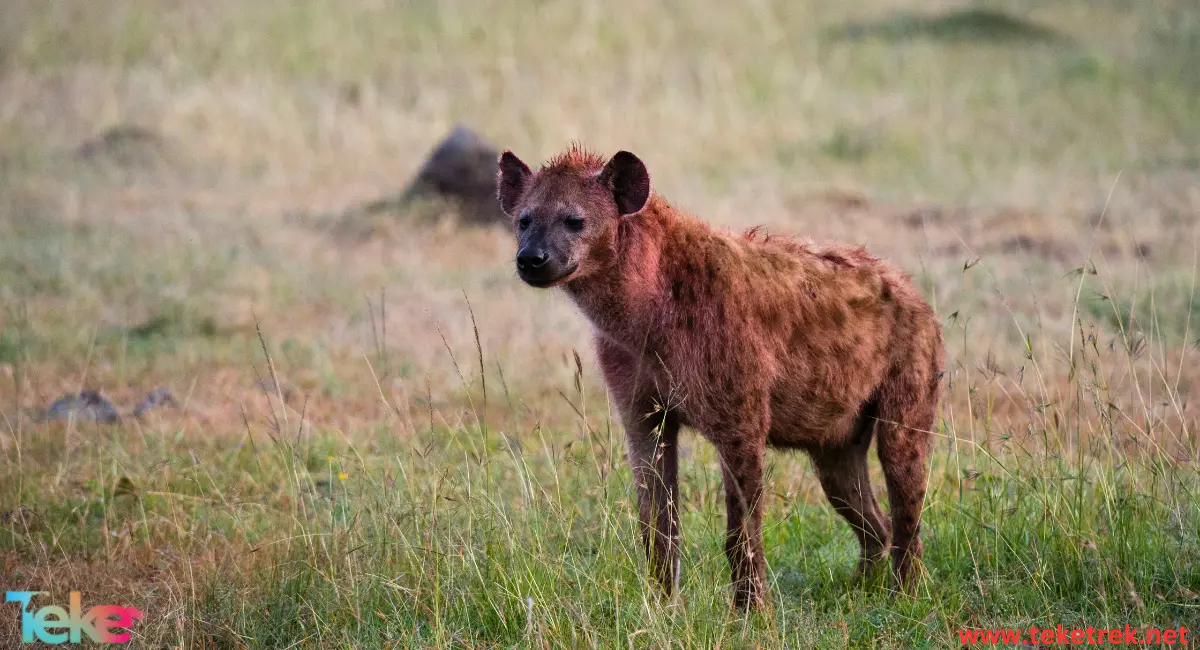The hyena is one of the most controversial animals in the wild, combining strength, intelligence, and ferocity all at once. It is characterized by its powerful body and incredible speed, making it one of the fiercest predators that dominate the ecosystem.
It’s worth noting that the hyena hides aspects of its beauty and important role in nature, deserving a deeper understanding and further exploration of this powerful creature.
In this article from teketrek, we will provide you with plenty of important information about the hyena’s habitat, reproduction, diet, and other facts you may be curious about. Stay tuned.
About the hyena
The hyena is a vertebrate mammal belonging to the Canidae family, inhabiting various regions around the world such as Europe, Asia, North Africa, and North America. It is considered a nocturnal animal capable of adapting to different conditions. Hyenas vary in size, ranging from small to relatively large.
There are numerous species of hyenas around the world, found in various wild regions from deserts to rainforests. Each species is characterized by its unique traits and different lifestyles, making the study of these animals an intriguing challenge.

The species of hyenas
- The Brown Hyena (Hyaena brunnea) mates during the African dry season (May-August), and the gestation period for females lasts up to 97 days.
- The Spotted Hyena (Crocuta crocuta) mates throughout the year and reproduces every one and a half years, with an average gestation period for females of 110 days.
- The Striped Hyena (Hyaena hyaena) gives birth to 1-6 cubs throughout her life, and the gestation period lasts for three months.
- The Aardwolf (Proteles cristata) mates with one female throughout its life. Mating occurs throughout the year, and the gestation period lasts for 90 to 100 days.
6 tricks the hyena uses to lure its prey
The hyena is considered one of the most intelligent and cunning animals in nature, using several tricks to lure its prey. Here are some tricks that the hyena may use:
1. Camouflage: The hyena hides in dark places, among trees, or rocks, waiting for its prey to come without noticing it.
2. Swift Chase: The hyena utilizes its speed and agility to swiftly chase its prey, making it difficult for the prey to escape.
3. Stealth: Sometimes, the hyena approaches its prey slowly and cautiously without being noticed. When at an appropriate distance, it quickly leaps to catch the prey and attacks it suddenly.
4. Deception: The hyena may emit sounds resembling its prey to lure unsuspecting animals, waiting for the prey to investigate before attacking.
5. Cunning: Occasionally, the hyena uses clever tricks to lure its prey, such as pretending to be a food source to attract the prey.
6. Trap Setting: Sometimes, the hyena sets traps to lure its prey, such as pretending to be injured or weak.
In summary, the hyena relies on a variety of strategies and tactics to effectively and efficiently lure and hunt its prey.
5 characteristics that make the hyena an impressive creature
The hyena is an animal belonging to the family Hyaenidae, characterized by several features that make it unique and interesting. The most important of them:
1. Size:
The hyena is a large animal, weighing around 30 kilograms and measuring about 1.5 meters in length.
2. Color and Pattern:
The hyena’s distinguishing features include its thick fur, which comes in various colors such as brown, gray, and white. It also boasts a unique decorative pattern that varies according to the species.
3. Long Ears:
The hyena has long, rounded ears that help it hear sounds well and identify their source.
4. Nocturnal Vision:
The hyena has excellent night vision, enabling it to hunt its prey in darkness effectively.
5. Speed and Strength:
The hyena is a fast and powerful animal, capable of running at speeds of up to 60 kilometers per hour and leaping long distances.
These features make the hyena a unique and fascinating animal in the wild animal kingdom.
Where Do Hyenas Live? Natural Habitats of Hyenas Worldwide
Hyenas live in various regions of Asia and Africa, and each species prefers different types of habitats. For example, the striped hyena prefers dry areas such as savannas, wet grasslands, forests, and mountainous shrublands. The brown hyena prefers living in the plains of Africa, Mozambique, Namibia, and the Kalahari Desert, focusing on desert and semi-desert regions. The striped hyena lives in North Africa, Egypt, Tanzania, Morocco, the Arabian Peninsula, India, and the Caucasus, spreading across forests, dry, and semi-dry areas.
How Do Hyenas Raise Their Young? Hyena Life Cycle from Birth
Hyenas mate in different sectors, and female hyenas give birth to 2 to 4 cubs after a 3-month pregnancy. The cubs’ eyes remain closed for 5 to 9 days. The care of the cubs is the responsibility of the mother alone. The cubs rely heavily on their mother’s milk for nourishment until they reach the sixth month. Hyena cubs leave the den after their second week of life. The cubs remain dependent on their mother for up to a year or more and reach maturity by their second year.
Is the Hyena a Dog or a Cat?
Despite external similarities to some dogs or cats, the hyena belongs to neither. Scientifically, hyenas fall under the order Carnivora but form a separate family known as Hyaenidae. This family is genetically closer to mongooses and cats than to dogs, though it maintains unique features. For example, hyenas have strong teeth similar to those of dogs but display agility sometimes akin to that of cats.
Is the Hyena a Predator?
Yes, the hyena is a skilled predator, contrary to the stereotypical image of it being a scavenger reliant solely on carrion. Hyenas, especially the spotted hyena, are competent hunters capable of taking down large prey such as antelopes and other wild animals. They employ group hunting strategies based on coordination and intelligence, making them strong competitors in the wild. Nevertheless, hyenas won’t hesitate to eat carrion when the opportunity arises, reinforcing their reputation as “nature’s cleaners.”
Do Hyenas Eat Only Carrion?
The common belief that hyenas solely rely on carrion is a misconception. While they are known for consuming animal remains thanks to their strong teeth and digestive systems, they are also efficient hunters. Studies show that spotted hyenas, for instance, obtain about 60–70% of their food through direct hunting. They also consume a variety of foods, including insects and fruits on occasion, making them opportunistic feeders.
Do Hyenas Attack Humans?
Hyena attacks on humans are extremely rare and typically occur under exceptional conditions, such as food shortages or when humans encroach on their habitat. Hyenas are cautious animals that prefer to avoid people. However, in some rural areas of Africa, encounters may happen due to humans approaching hyena dens or leaving food scraps that attract them. Therefore, caution is always advised in areas inhabited by hyenas.
Do Hyenas Live in Groups?
Hyenas are highly social animals, especially the spotted hyena, which lives in groups known as “clans.” These groups can include up to 80 individuals and have a complex social structure usually led by females. Hyenas cooperate in hunting, territory defense, and raising young, enhancing their survival efficiency. In contrast, striped and brown hyenas tend to be more solitary or live in small groups.
What Is the Difference Between a Hyena and a Dog?
Despite superficial similarities, there are key differences between hyenas and dogs:
- Scientific classification: Dogs belong to the Canidae family, while hyenas belong to the Hyaenidae family.
- Body structure: Hyenas have much stronger jaws than dogs, capable of crushing bones with ease.
- Social behavior: Hyenas, particularly spotted ones, live in complex social structures led by females, while dog social structures vary by species.
- Diet: Hyenas are more opportunistic, feeding on carrion and hunted prey, while dogs may have a more varied diet.
Does the Hyena’s Sound Resemble Laughter?
The sound of a hyena, especially the spotted hyena, resembles human laughter, earning it the nickname “laughing hyena.” This sound is actually a communication tool used to express excitement, tension, or to interact with clan members. The pitch and tone vary depending on the context, and it may serve to indicate identity or signal danger.
Where Does the Hyena Live?
Hyenas primarily inhabit Africa, with some species found in Asia and the Middle East. The spotted hyena prefers savannas and grasslands in East and Southern Africa, while the striped hyena is found in North Africa, the Middle East, and parts of Asia. The brown hyena is limited to Southern Africa. Hyenas adapt to diverse environments, from deserts to open forests.
What Do Hyenas Eat?
Hyenas are opportunistic feeders consuming a wide range of food:
- Live prey: Such as antelope, gazelles, and small animals.
- Carrion: Thanks to their strong digestive systems, hyenas can consume animal remains, including bones.
- Insects and plants: Occasionally, hyenas eat insects or fruit as a dietary supplement.
Spotted hyenas are known for their ability to hunt large prey, whereas striped hyenas may rely more on scavenging.
How Long Does a Hyena Live?
In the wild, a hyena’s lifespan ranges between 12 and 20 years, depending on the species and environmental conditions. In captivity, hyenas may live up to 25 years due to proper care and food availability. Factors influencing lifespan include food access, competition with other animals, and disease.
Are Hyenas Hermaphrodites?
This question arises from a common misunderstanding about the spotted hyena, where females exhibit male-like features due to high levels of testosterone. Female spotted hyenas possess external genitalia resembling that of males, a phenomenon known as “pseudo-penis.” However, hyenas are not hermaphrodites; they are either male or female. This unique trait has attracted scientific and cultural attention.
Do Hyenas Help Clean the Environment?
Yes, hyenas play a vital role in cleaning the environment. Thanks to their ability to consume carrion and bones, hyenas help reduce the spread of diseases that could result from decomposing animal remains. They also contribute to maintaining ecological balance by preying on weak or sick animals.
Are Hyenas Endangered?
The conservation status of hyenas varies by species. The spotted hyena is not currently endangered and is relatively widespread in Africa. However, the brown hyena is considered threatened due to habitat loss. The striped hyena also faces threats from hunting and habitat destruction. Preserving hyenas requires protecting their habitats and reducing human-wildlife conflict.
How Fast Can a Hyena Run?
Hyenas are relatively fast animals. The spotted hyena can reach speeds of up to 60 kilometers per hour when running. This speed enables them to efficiently chase prey, especially during group hunts. However, hyenas rely more on endurance than top speed, allowing them to pursue prey over long distances.
Can Hyenas Be Domesticated?
Domestication of hyenas is possible but extremely difficult. Hyenas are wild animals with strong instincts, making them less domesticated than dogs or cats. In some cultures, hyenas have been tamed for guarding or performance purposes, but this requires intensive training and significant expertise. Hyenas retain their wild nature, making them unsuitable as pets in most cases.
Strange Facts About Hyenas That May Surprise You!
There are many surprising facts about hyenas, including:
- Hyenas actually resemble cats more than dogs, contrary to popular belief.
- Hyenas only live in groups called clans, with a clan containing up to 80 hyenas.
- Hyenas feed on dead animals, benefiting from the remains of other animals’ prey, and also hunt wild animals such as birds, lizards, snakes, gazelles, and foxes.
- Unlike other predators, hyenas enjoy eating their meals while the animals are still alive.
- Some hyena species, such as the spotted hyena, are capable of running at speeds of up to 60 km/h.
- A particular species of hyena makes a sound that resembles human laughter, such as the spotted hyena.
- Female hyenas lead the clans, not the males.
Hyenas have an excellent sense of smell that helps them detect prey from a distance.
What are the benefits of hyenas? What does it offer to the environment?
By understanding the benefits of hyenas, we can comprehend the importance of protecting them and conserving the balance of the ecosystems they inhabit.
1. Regulating Animal Numbers: Hyenas play a crucial role in regulating animal populations in the wild by controlling the food chain and managing prey numbers.
2. Disease Control: Hyenas contribute to preventing the spread of diseases among wild animals by reducing the number of infected prey.
3. Plant Growth Regulation: Hyenas help regulate the growth of grasses and plants by influencing the populations of animals that feed on these plants.
4. Biodiversity Conservation: Hyenas are essential for preserving biodiversity in wild areas, as they contribute to maintaining balance among living organisms.
5. Cultural Heritage: Hyenas are part of the natural and cultural heritage of many societies that value this animal and promote its protection.
6. Predator Population Regulation: Hyenas help regulate the numbers of other predator animals and prevent their increase to unsustainable levels.
7. Ecological Contribution: Hyenas are part of the natural food chain, playing a significant role in converting organic matter into energy.
8. Seed Dispersal: Hyenas contribute to the distribution of plant seeds by consuming animals that eat these plants and transport their seeds.
9. Ecosystem Balance: Hyenas form part of the environmental and ecological balance in the areas they inhabit, and protecting them contributes to the stability of these ecosystems.
How Do Hyenas Sleep? Sleeping and Resting Habits of Hyenas
Hyenas are nocturnal animals, meaning they are most active at night when hunting. They have various resting habits and sleep in dens that they dig themselves, or rest in tall grasses or between rocks.
How Do Hyenas Communicate? Body Language and Sounds
Hyenas communicate with each other using different languages that are difficult for humans to understand. They produce various vocalizations for different purposes, such as sounds related to mating or hunting. The intensity of these sounds varies, and they also make laughing sounds to express their emotional state, which can instill fear and panic in their prey. They also make coarse sounds that resemble snoring and use loud cries to express discomfort. Hyenas communicate with their species through body movements such as ear twitching, raising their paws, and other gestures.
The Role of Hyenas in Ancient Cultures and Mythologies
Many myths and imaginations about hyenas have spread through folklore, such as the belief that hyenas are unintelligent creatures. However, in reality, they are highly intelligent and capable of solving many problems. Their intelligence is particularly evident in their hunting methods and their fearlessness when facing lions. They have been viewed as frightening, harmful creatures that threaten the environment and humans. But the truth is, hyenas play a crucial role in maintaining environmental balance by eliminating carrion and dead prey, thus reducing the risk of diseases and threats to the ecosystem.
It has also been said that hyenas have a foul odor and dig up graves to consume corpses. However, studies have shown that their scent is not unpleasant and is used to mark their locations.
Hyenas and Humans: Do They Pose a Danger to Humans?
Hyenas are predatory animals, but they are generally shy and avoid humans. However, since they are nocturnal creatures, some species, like the spotted and striped hyenas, may exhibit bold behavior toward humans, especially at night. They might hunt and attack humans in rare instances.
Comparing Hyenas with Other Predators
Hyenas differ from other predators in that they do not hunt prey to kill it first, unlike most predators. Instead, they often torment their prey while it is still alive. They are also scavengers, feeding on carrion and the remains of other predators’ kills, unlike other predators that hunt and kill their own prey.
Hyenas and Extinction
Hyenas face many threats from humans, including poaching and overhunting. They have been associated with myths and folklore as terrifying creatures that disturb graves and threaten people’s souls. Some people hunt hyenas to use parts of their bodies for magical purposes, while others exploit their tough hides for smuggling drugs, as it is difficult to detect what is hidden under their skin. Consequently, hyenas are hunted by humans, putting their survival at risk and making them vulnerable to extinction.
Anatomical Structure of the Hyena’s Jaw
We all know a great deal about the hyena’s power and dominance in nature, not to mention the immense fear it causes in anyone who sees it. Most people attribute this to its strong jaw, which clearly shows signs of strength and savagery. When examined under a microscope, this jaw reveals very powerful muscles such as the masseter and temporalis, in addition to sharp teeth and strong canines, enabling it to crush bones and tear flesh effortlessly. Moreover, it possesses a strong physical build covered in thick skin and coarse fur, which allows it to hunt and endure harsh conditions.
Hyena and Behavioral Intelligence: The Genius of a Predator
In reality, hyenas exhibit a high level of social intelligence, which helps them communicate smoothly with their peers. Consequently, they cooperate in hunting their prey in a professional manner using complex strategies that rely on their sharp intellect. It is also worth noting that this formidable animal can adapt to its surrounding environment, regardless of the conditions.
The Hyena in Ancient Mythology: Between Legend and Reality
Hyenas have long been portrayed as creatures symbolizing evil and deception in many ancient cultures. In African folklore and mythology, for example, the hyena is seen as a cunning creature that cannot be trusted. Its image in popular heritage is often associated with negativity and trickery. However, it’s important to say that this stereotype is somewhat unfair, as hyenas play a crucial role in natural ecosystems.
The Hyena in Cinema and Literature: From Eternal Villain to a New Perspective
Whether in movies or video games, the hyena has always been cast as the deceptive villain. Recently though, some transformations in its character portrayal have emerged in various artistic works, showcasing its complex personality, intelligence, and resilience. Although traditionally seen as purely evil in films and books, the advancement of environmental science and behavioral studies has led to a growing appreciation of the hyena’s role in the ecosystem, improving its public image overall.
What Modern Science Says About Hyenas: New Studies, New Perspectives
Modern science currently emphasizes the importance of hyenas in maintaining ecological balance. Their main diet consists of carrion and organic waste, making them key players in environmental cleanup and disease prevention. Additionally, ongoing research highlights their high social intelligence. Hyenas hunt as a coordinated group and instinctively engage in complex behaviors like vocal and physical communication. Some studies even show that hyenas can adapt to environmental changes such as food shortages or competition with other animals. Furthermore, they help control populations of other species, greatly contributing to biodiversity.
Hyenas as Pets: The Truth Behind Their Domestication in Some Cultures
Many cultures have believed that hyenas are symbols of good luck and household protection, leading some to treat them as pets. However, in reality, these animals are predators and inherently aggressive. They are not tamable. Many African folktales recount how tribes would raise hyenas and include them in their lives. Yet such practices can be extremely risky, as hyenas may become dangerously aggressive, posing threats to both individuals and families.
The Hyena as Nature’s Cleaner: A Life Cycle from Death to Renewal
Generally, every living being in nature plays a specific role in maintaining ecological balance. The hyena is a carnivore that functions as a tertiary or quaternary consumer in the food chain. It feeds on a variety of animals from birds to rabbits and sheep. It’s also considered a scavenger, feeding on dead animals and organic waste. By consuming carcasses, hyenas help release the energy stored in those bodies back into the ecosystem, making them vital players in environmental protection.
Astonishing Hyena Statistics: What Documentaries Don’t Tell You
Hyenas are mainly found in Africa, with some species living in parts of Asia and the Middle East—such as the spotted and striped hyena. Their global population is estimated at around 1.5 million individuals. In the wild, they can live up to about ten years, while in captivity, they may live up to twenty years due to the absence of threats. They can run at speeds of 30 to 40 kilometers per hour.
Hyena vs. Lion: A Never-Ending Rivalry
Let’s now talk about one of nature’s most well-known rivalries: hyenas versus lions, famously dubbed the clash of titans. Both are predators and act as tertiary or quaternary consumers. They also rely on similar food sources, increasing competition. In terms of strength, lions are typically larger and more muscular, giving them a direct hunting advantage. However, hyenas possess great social intelligence and exceptional teamwork, which sometimes allows them to overpower lions, especially when in large numbers.
Are Hyenas Really Endangered?
Generally, hyenas are not considered highly endangered. However, the striped hyena does face habitat loss and population decline due to unregulated hunting and urban sprawl in many areas. Sudden climate changes have also visibly affected their natural habitats. As a result, several governments have launched monitoring and conservation programs to protect hyena populations and preserve ecological balance.
frequently asked questions about the hyena
1- What distinguishes hyenas?
Hyenas possess immense jaw strength, allowing them to hunt and crush bones. They are also recognized for their high intelligence, strength, speed, adaptability, excellent camouflage, unique vocalizations, proficient hunting skills, and complex social life.
2- Does a hyena’s gender change over the years?
Many rumors are suggesting that hyenas may be females in one year and males in another. However, this is not true as scientists have confirmed that hyenas are mammals with fixed genders.
3- Do hyenas dig graves?
Yes, hyenas are fond of digging graves due to their appetite for human flesh.
4- What do hyenas eat?
Hyenas feed on a variety of small and medium-sized animals, including rodents like rats, rabbits, and squirrels, in addition to small birds, reptiles, and insects. They may also hunt other animals such as wild rabbits and wild boars if available in their habitat.
5- What is the hyena’s cry called, and how fast can it run?
The hyena produces a cry known as “howling,” a distinctive sound that can be heard for miles in the wilderness. It uses this sound for communication with other pack members, marking territorial boundaries, or signaling the presence of prey. As for the hyena’s speed. hyenas can run at speeds ranging from 40 to 50 kilometers per hour, but they can reach speeds of up to 70 kilometers per hour in some cases when they need to flee or chase.
6- How do hyenas mate?
During the mating season, hyenas interact with each other to find a mate. The mating process requires practice and experience for the male hyena to mount behind the female and assume a suitable position for mating. Afterward, the female undergoes a gestation period lasting about 2-3 months before giving birth to her cubs.


7- How much does a hyena weigh?
Hyenas can weigh up to 50 kilograms, smaller than the African spotted hyena, which weighs 90 kilograms.
8- What is the average lifespan of a hyena ?
hyenas can live for 10 to 15 years in the wild.
- How does a hyena control a human?
The striped hyena, being a nocturnal animal, possesses great physical strength and sharp senses, which makes it dangerous when it feels threatened or needs food, so it can control humans.
- What distinguishes a hyena?
The hyena is distinguished by its attractive and colorful appearance, in addition to its speed, great physical strength, and sharpness while hunting. It also has the ability to adapt to its surrounding environment, which makes it a powerful and majestic animal.
In conclusion
hyenas are essential animals in the ecosystem, playing a vital role in regulating wildlife and maintaining environmental balance. Therefore, we must all recognize the importance of protecting this magnificent animal and work to preserve its presence in the wild to ensure the continuity of environmental balance and preserve the beauty of nature.






